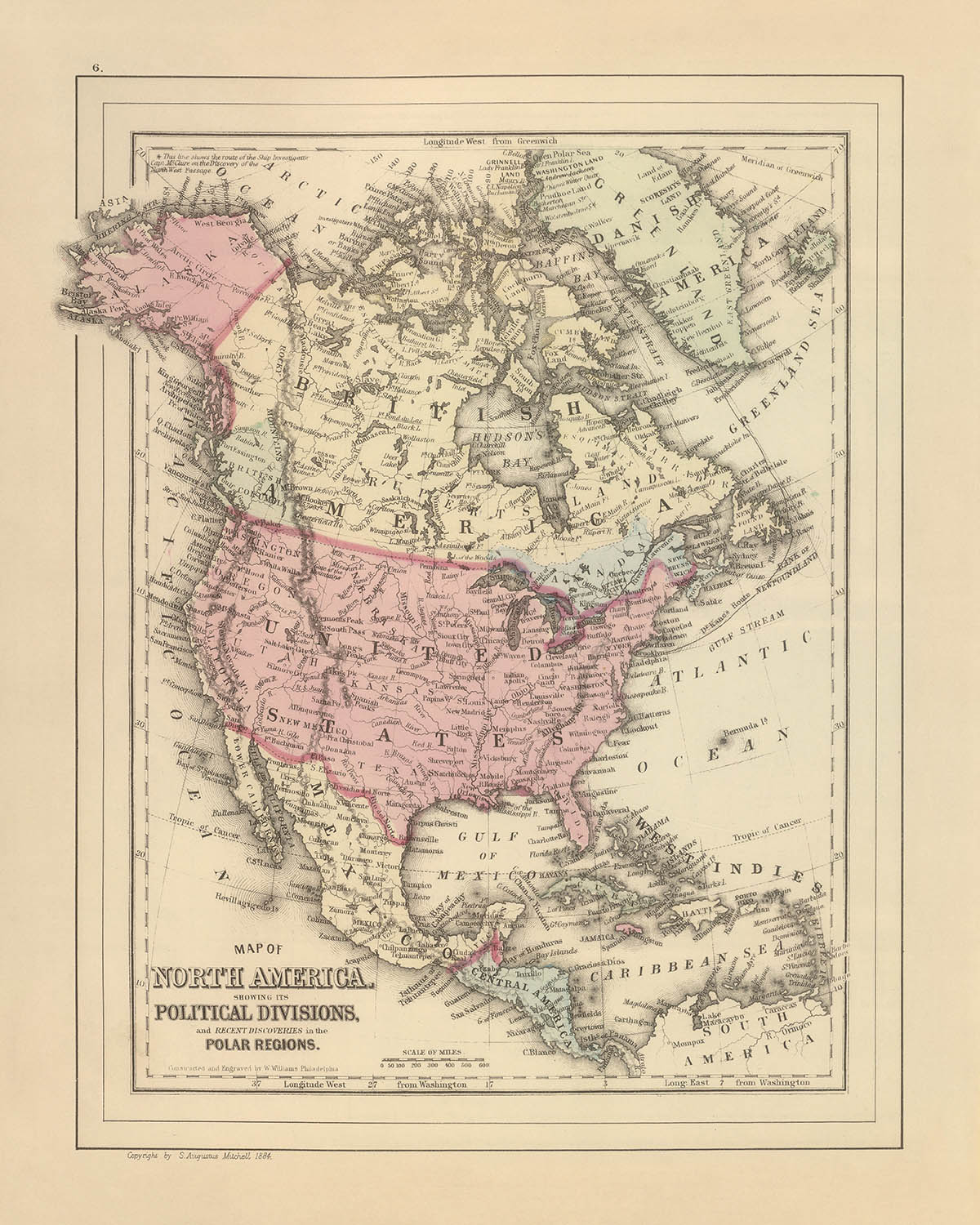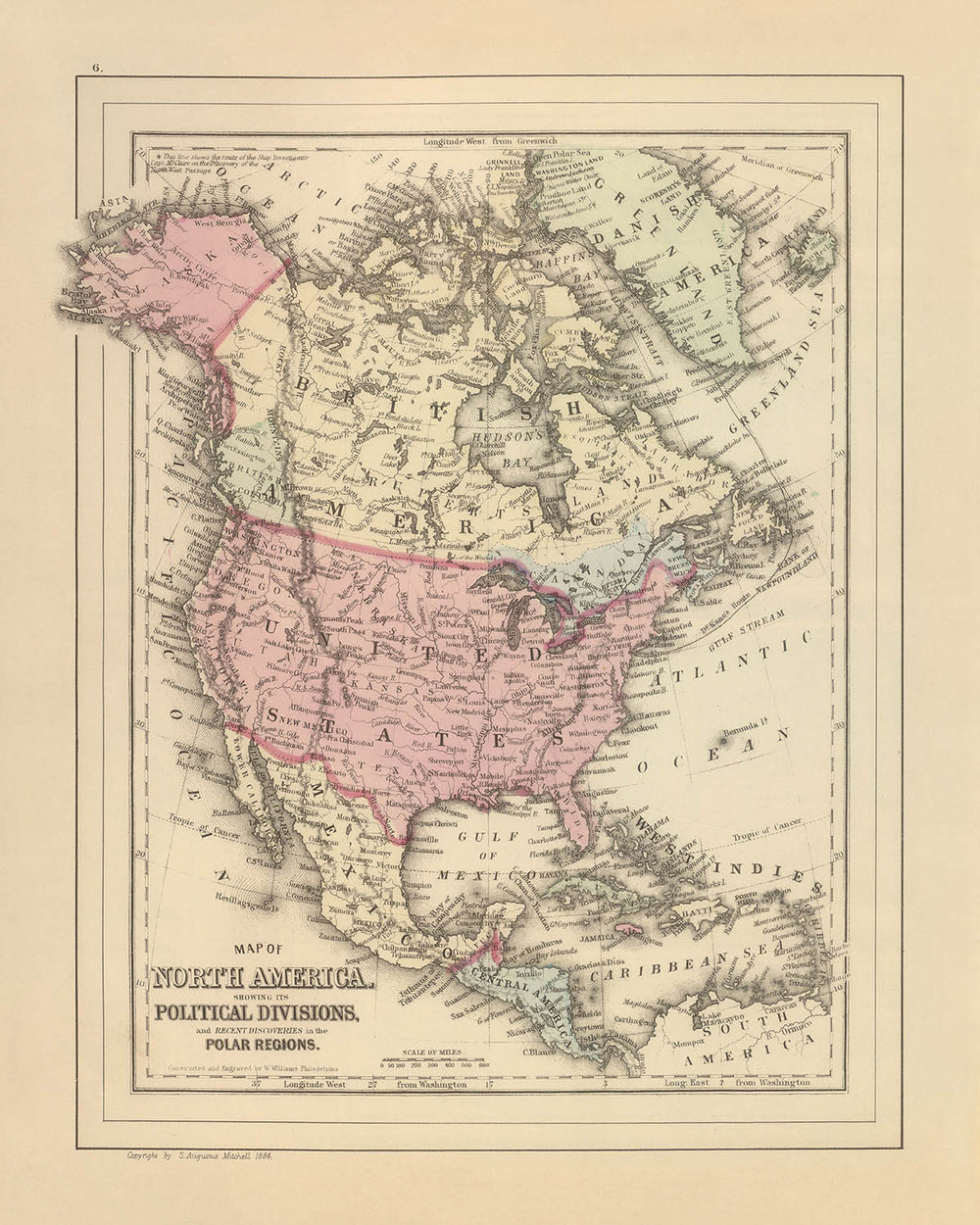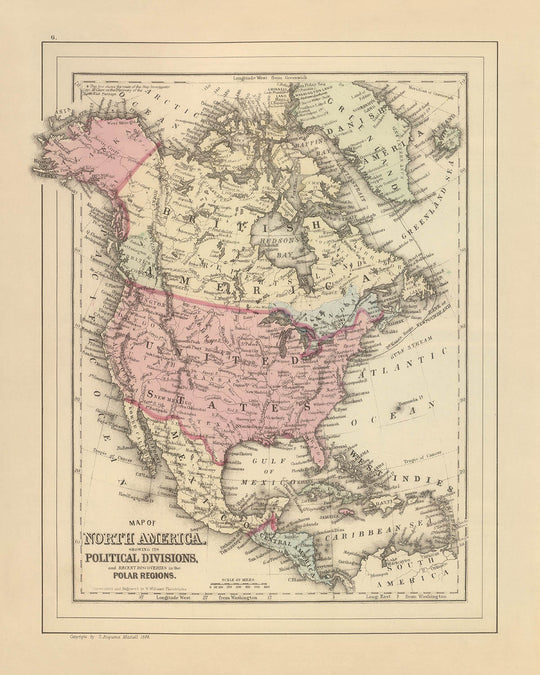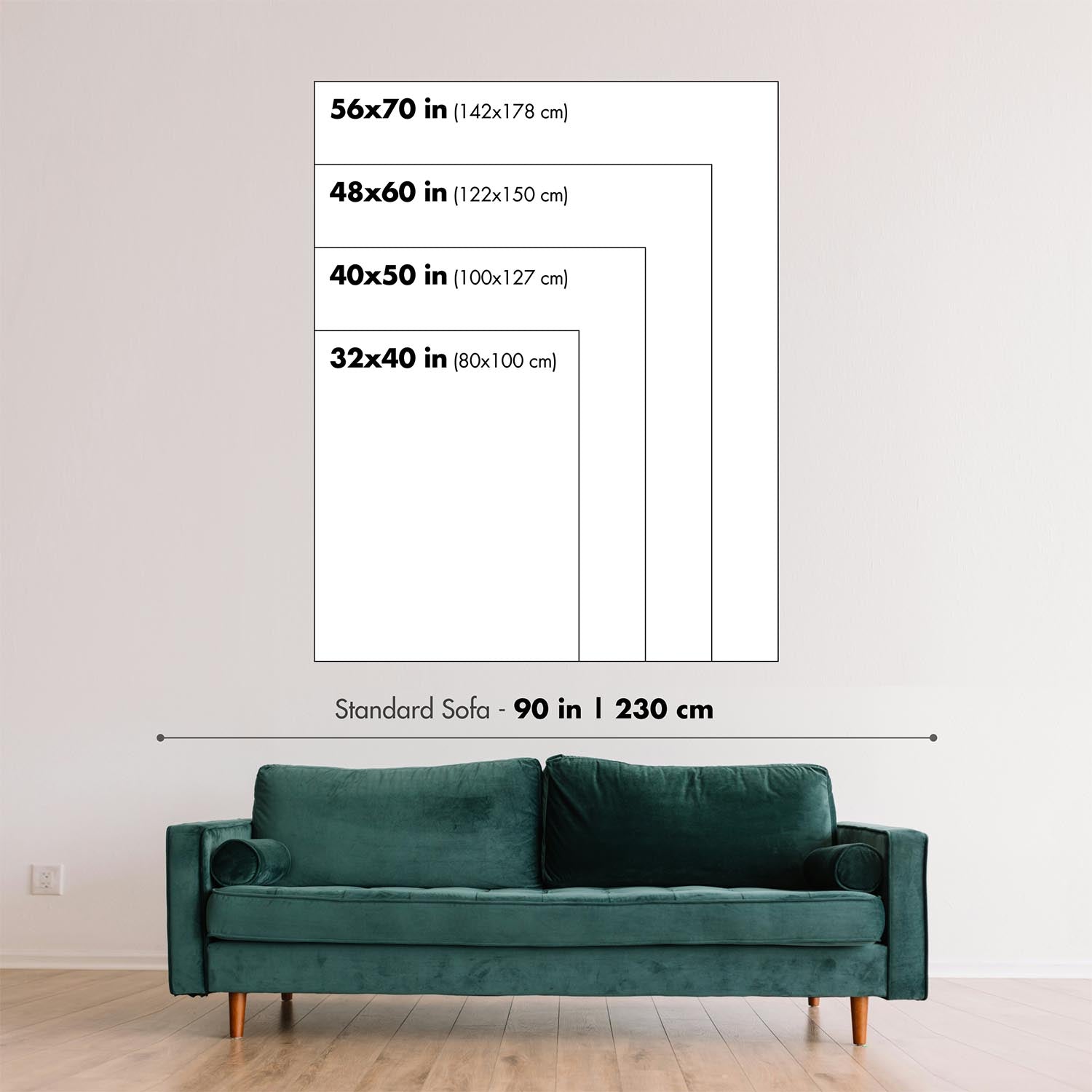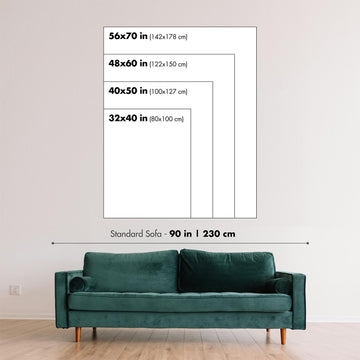- Handmade locally. No import duty or tax
- FREE Delivery by Christmas
- Love it or your money back (90 days)
- Questions? WhatsApp me any time
Own a piece of history
5,000+ 5 star reviews


The "Map of North America. Showing its political divisions, and recent discoveries in the Polar Regions" is a masterful creation by the esteemed cartographer Samuel Augustus Mitchell, published in 1884. This map captures the geopolitical landscape of North America during a period of significant exploration and territorial evolution. It highlights the political boundaries of the United States, Mexico, Central America, and a notably small Canada, which at the time consisted only of British Columbia and parts of Ontario and Quebec. The remaining expanse of what we now know as Canada is labeled as "British America," reflecting the colonial perspectives of the era.
Samuel Mitchell, a renowned American geographer, and publisher, was instrumental in bringing detailed and accurate maps to the public during the 19th century. His works are celebrated for their precision and the wealth of information they provide. This particular map not only delineates political boundaries but also incorporates recent discoveries in the Polar Regions, showcasing the adventurous spirit and the relentless pursuit of knowledge that characterized the age of exploration.
The map is a visual feast, with its detailed representation of North America's physical features. The Rocky Mountains and the Appalachian Mountains are prominently displayed, providing a sense of the continent's diverse topography. Major bodies of water such as Hudson's Bay, the Atlantic Ocean, the Pacific Ocean, the Gulf of Mexico, and the Caribbean Sea are meticulously labeled, guiding the viewer through the natural landmarks that define the region. The inclusion of the Arctic Ocean and the polar regions underscores the era's fascination with the unknown and the uncharted.
Cities and towns are carefully marked, offering a glimpse into the urban centers of the time. In the United States, cities like New York, Philadelphia, Washington, Boston, New Orleans, and San Francisco are highlighted, reflecting their importance as hubs of commerce, politics, and culture. In Canada, Montreal and Quebec stand out, while Mexico City is prominently featured in Mexico. Havana is also noted in the Caribbean, illustrating the map's comprehensive coverage of significant settlements across the continent.
This map is not just a geographical document; it is a historical artifact that provides insight into the political and cultural dynamics of North America in the late 19th century. It reflects the territorial claims, the exploration achievements, and the urban development of the time. Owning this map is akin to holding a piece of history, a testament to the cartographic skill of Samuel Mitchell and the ever-evolving story of North America.
Cities and towns on this map
- United States:
- New York
- Philadelphia
- Washington
- Boston
- New Orleans
- San Francisco
- Canada:
- Montreal
- Quebec
- Mexico:
- Mexico City
- Caribbean:
- Havana
Notable Features & Landmarks
- Bodies of water:
- Hudson's Bay
- Atlantic Ocean
- Pacific Ocean
- Gulf of Mexico
- Caribbean Sea
- Arctic Ocean
- Borders:
- Political boundaries between countries and regions
- Mountains:
- Rocky Mountains
- Appalachian Mountains
- Other notable features:
- Polar Regions with recent discoveries labeled
Historical and design context
- Name of the map: Map of North America. Showing its political divisions, and recent discoveries in the Polar Regions.
- Date of creation: 1884
- Mapmaker/Publisher: Samuel Mitchell
- Interesting context about the mapmaker: Samuel Augustus Mitchell was a prominent American geographer and publisher of maps and atlases in the 19th century.
- Topics and themes shown on the map:
- Political divisions: The map highlights the political boundaries and divisions of North America as understood in 1884.
- Recent discoveries in the Polar Regions: The map includes information on recent explorations and discoveries in the Arctic regions.
- Countries and regions shown on the map:
- United States
- Canada (notably small)
- British America
- Mexico
- Central America
- Greenland
- The Caribbean
- Design or style of the map:
- The map is detailed with both political and physical features, using color to distinguish different regions and countries.
- It includes detailed labeling of geographical features and political boundaries.
- Historical significance or context:
- The map reflects the geopolitical understanding and territorial claims of the late 19th century.
- It provides insight into how regions like Canada were perceived and divided before they achieved their modern boundaries.
Please double check the images to make sure that a specific town or place is shown on this map. You can also get in touch and ask us to check the map for you.
This map looks great at every size, but I always recommend going for a larger size if you have space. That way you can easily make out all of the details.
This map looks amazing at sizes all the way up to 50in (125cm). If you are looking for a larger map, please get in touch.
The model in the listing images is holding the 16x20in (40x50cm) version of this map.
The fifth listing image shows an example of my map personalisation service.
If you’re looking for something slightly different, check out my collection of the best old maps to see if something else catches your eye.
Please contact me to check if a certain location, landmark or feature is shown on this map.
This would make a wonderful birthday, Christmas, Father's Day, work leaving, anniversary or housewarming gift for someone from the areas covered by this map.
This map is available as a giclée print on acid free archival matte paper, or you can buy it framed. The frame is a nice, simple black frame that suits most aesthetics. Please get in touch if you'd like a different frame colour or material. My frames are glazed with super-clear museum-grade acrylic (perspex/acrylite), which is significantly less reflective than glass, safer, and will always arrive in perfect condition.
This map is also available as a float framed canvas, sometimes known as a shadow gap framed canvas or canvas floater. The map is printed on artist's cotton canvas and then stretched over a handmade box frame. We then "float" the canvas inside a wooden frame, which is available in a range of colours (black, dark brown, oak, antique gold and white). This is a wonderful way to present a map without glazing in front. See some examples of float framed canvas maps and explore the differences between my different finishes.
For something truly unique, this map is also available in "Unique 3D", our trademarked process that dramatically transforms the map so that it has a wonderful sense of depth. We combine the original map with detailed topography and elevation data, so that mountains and the terrain really "pop". For more info and examples of 3D maps, check my Unique 3D page.
For most orders, delivery time is about 3 working days. Personalised and customised products take longer, as I have to do the personalisation and send it to you for approval, which usually takes 1 or 2 days.
Please note that very large framed orders usually take longer to make and deliver.
If you need your order to arrive by a certain date, please contact me before you order so that we can find the best way of making sure you get your order in time.
I print and frame maps and artwork in 23 countries around the world. This means your order will be made locally, which cuts down on delivery time and ensures that it won't be damaged during delivery. You'll never pay customs or import duty, and we'll put less CO2 into the air.
All of my maps and art prints are well packaged and sent in a rugged tube if unframed, or surrounded by foam if framed.
I try to send out all orders within 1 or 2 days of receiving your order, though some products (like face masks, mugs and tote bags) can take longer to make.
If you select Express Delivery at checkout your order we will prioritise your order and send it out by 1-day courier (Fedex, DHL, UPS, Parcelforce).
Next Day delivery is also available in some countries (US, UK, Singapore, UAE) but please try to order early in the day so that we can get it sent out on time.
My standard frame is a gallery style black ash hardwood frame. It is simple and quite modern looking. My standard frame is around 20mm (0.8in) wide.
I use super-clear acrylic (perspex/acrylite) for the frame glass. It's lighter and safer than glass - and it looks better, as the reflectivity is lower.
Six standard frame colours are available for free (black, dark brown, dark grey, oak, white and antique gold). Custom framing and mounting/matting is available if you're looking for something else.
Most maps, art and illustrations are also available as a framed canvas. We use matte (not shiny) cotton canvas, stretch it over a sustainably sourced box wood frame, and then 'float' the piece within a wood frame. The end result is quite beautiful, and there's no glazing to get in the way.
All frames are provided "ready to hang", with either a string or brackets on the back. Very large frames will have heavy duty hanging plates and/or a mounting baton. If you have any questions, please get in touch.
See some examples of my framed maps and framed canvas maps.
Alternatively, I can also supply old maps and artwork on canvas, foam board, cotton rag and other materials.
If you want to frame your map or artwork yourself, please read my size guide first.
My maps are extremely high quality reproductions of original maps.
I source original, rare maps from libraries, auction houses and private collections around the world, restore them at my London workshop, and then use specialist giclée inks and printers to create beautiful maps that look even better than the original.
My maps are printed on acid-free archival matte (not glossy) paper that feels very high quality and almost like card. In technical terms the paper weight/thickness is 10mil/200gsm. It's perfect for framing.
I print with Epson ultrachrome giclée UV fade resistant pigment inks - some of the best inks you can find.
I can also make maps on canvas, cotton rag and other exotic materials.
Learn more about The Unique Maps Co.
Map personalisation
If you're looking for the perfect anniversary or housewarming gift, I can personalise your map to make it truly unique. For example, I can add a short message, or highlight an important location, or add your family's coat of arms.
The options are almost infinite. Please see my map personalisation page for some wonderful examples of what's possible.
To order a personalised map, select "personalise your map" before adding it to your basket.
Get in touch if you're looking for more complex customisations and personalisations.
Map ageing
I have been asked hundreds of times over the years by customers if they could buy a map that looks even older.
Well, now you can, by selecting Aged before you add a map to your basket.
All the product photos you see on this page show the map in its Original form. This is what the map looks like today.
If you select Aged, I will age your map by hand, using a special and unique process developed through years of studying old maps, talking to researchers to understand the chemistry of aging paper, and of course... lots of practice!
If you're unsure, stick to the Original colour of the map. If you want something a bit darker and older looking, go for Aged.
If you are not happy with your order for any reason, contact me and I'll get it fixed ASAP, free of charge. Please see my returns and refund policy for more information.
I am very confident you will like your restored map or art print. I have been doing this since 1984. I'm a 5-star Etsy seller. I have sold tens of thousands of maps and art prints and have over 5,000 real 5-star reviews. My work has been featured in interior design magazines, on the BBC, and on the walls of dozens of 5-star hotels.
I use a unique process to restore maps and artwork that is massively time consuming and labour intensive. Hunting down the original maps and illustrations can take months. I use state of the art and eye-wateringly expensive technology to scan and restore them. As a result, I guarantee my maps and art prints are a cut above the rest. I stand by my products and will always make sure you're 100% happy with what you receive.
Almost all of my maps and art prints look amazing at large sizes (200cm, 6.5ft+) and I can frame and deliver them to you as well, via special oversized courier. Contact me to discuss your specific needs.
Or try searching for something!







